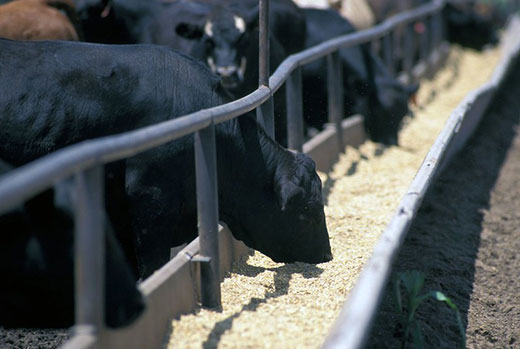
Cattle producers should consult with a nutritionist before making key decisions on extending the amount of time they feed cattle. |
Download this photo
Bottleneck in beef industry pushes producers into making key decisions
K-State beef team outlines feeding options during online workshop
May 15, 2020
MANHATTAN, Kan. – Several members of Kansas State University’s extension beef team hosted an online workshop Thursday to help producers with looming decisions on managing their herds in light of unique challenges in the market.
The COVID-19 pandemic has slowed Kansas’ beef supply chain to as much as 40 percent capacity, though the state has rebounded in recent days, according to K-State agricultural economist Glynn Tonsor.
Tonsor noted that the U.S. Department of Agriculture reported on March 30 that Kansas’ commercial cattle slaughter numbers were 120,000 head per day, “but then throughout the month of April, we’ve had almost day after day decline in the number of animals we were able to harvest,” he said.
Though the numbers from USDA are preliminary, Tonsor said the volume fell to as low as 72,000 – a nearly 40 percent reduction in the number of animals harvested over the same period in 2019.
“The good news is that over the last 10 days, we’ve had improvement,” Tonsor said, noting that the May 13 numbers indicate that 91,000 animals were harvested that day. “We continue to make progress. I anticipate that to continue, but there is a long road ahead to get closer to a feasible total capacity in the weeks and months ahead.”
The bottleneck in beef processing facilities due to COVID-19 has led to less meat available at grocery stores, as well as higher meat prices, and lower livestock prices for producers and processors.
Because they can’t move their animals to processing, livestock producers have had to adjust their management strategy to feed animals longer and sell them at heavier weights. To manage that most efficiently, K-State Research and Extension beef extension specialist Dale Blasi said producers should know the average weight of the calves currently in their operation.
“Knowing this is critical to assess your marketing strategy,” he said. “It allows you to examine how rations can be formulated with available feed ingredients at the least possible cost.”
He encourages cattlemen to use the feeder cattle risk management tool available from the K-State Department of Agricultural Economics, which compares net selling prices under futures market hedging, buying put options and the USDA’s Livestock Risk Protection insurance plan.
Jaymelynn Farney, a beef systems specialist at the Southeast Research-Extension Center in Parsons, noted that the slowdown in the supply chain has come at a time when one of producers’ preferred feed ingredients – dried distiller’s grains – is also limited due to COVID-19 and factors related to the availability of crude oil.
“So right now, we’re trying to replace distiller’s grains with protein alternatives,” she said. “The best options depend on where you’re located in the state or country.”
In the eastern part of the state, she said some of the commodities that can match or exceed distiller’s grains for the animals protein needs include corn gluten meal, corn steep, soybean meal, whole soybeans or sunflower meal.
“You always want to evaluate what commodities you have in your area, and the cost per pound, depending on what you’re wanting to use that commodity for – protein or energy,” she said.
In western Kansas, Justin Waggoner, a beef systems specialist for the Southwest Research-Extension Center in Garden City, also has looked at alfalfa as an alternative protein source. “It’s a good forage,” he said, “but it’s still variable in quality.”
Farney and Waggoner note that before deciding on the best protein source to substitute for distiller’s grains, producers should visit with their nutritionist.
To view the full May 14 webinar with the members of K-State’s beef extension team, visit KSUBeef.org.

